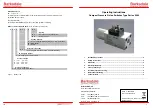
10
MATRIX SWITCH
3. Installation
Before you begin, make sure that the Matrix Switch is unplugged.
The ports on the serial Matrix Switch units are bidirectional, so that
computers and peripherals may be placed on either ports labeled A-D or 1-
8. This means that either 4 users can share 8 peripherals or 4 peripherals
can be shared among 8 users. Although ports A-D are listed below as
peripheral ports, they may be used to connect to computers instead. The
same is true with the ports labeled 1-8. See the appendix for serial-port
pinouts.
The parallel version of the Switch can have bidirectional IEEE Std 1284-
1994 compliant data transfer, supporting Compatibility and Nibble modes.
Make sure that the computers are communicating properly with the
peripherals directly. Centronics
®
standard type cables are usually used
when connecting computers to parallel printers. The cable required is
terminated on one end with a Centronics connector and on the other end
with a DB25 connector.
3.1 Parallel Installation
Proceed as follows to install the Matrix Switch in a parallel application:
1. Connect the printers with Centronics type cables (part number
EQN202) to the peripheral ports A through D.
2. Connect the computers to the ports labeled 1 through 8 (or 1 through
4 where applicable) with DB25 type straight-through cables (male and
female connectors, part number EQN201). Note that these cables must
have all 25 wires active and connected to both ends of the cable directly.
If the cable is shielded, make sure that pin 1 is not connected to the
shield.
3. Apply power to the peripherals and computers connected to the Matrix
Switch. You may now power on and use your Matrix Switch unit
normally.
































